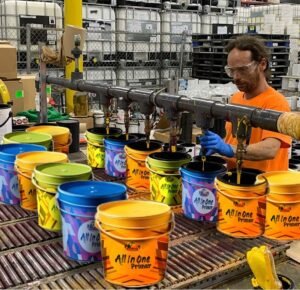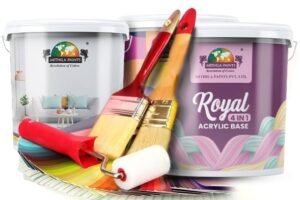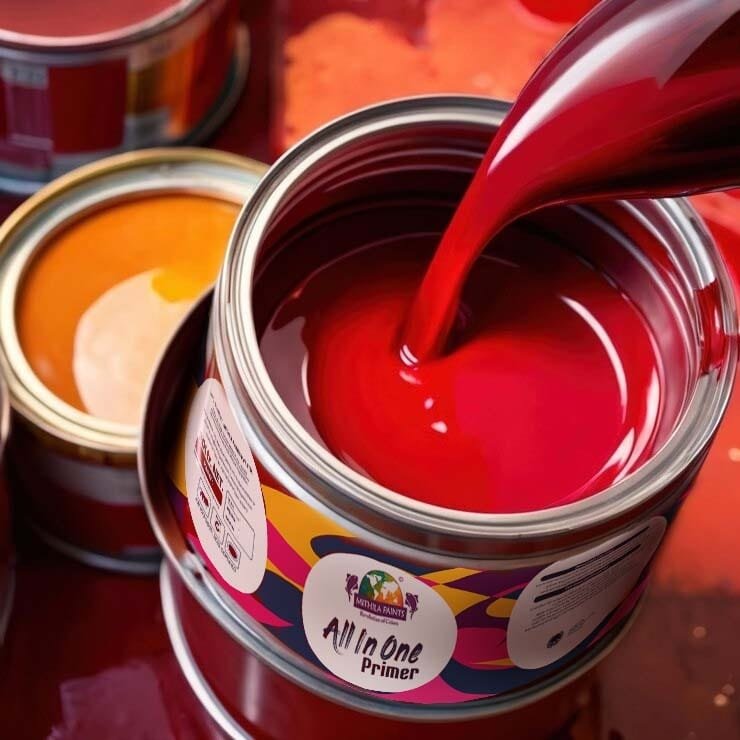Introduction to Paint Manufacturing
Mithila Paints, a prominent name in the paint manufacturing industry, was established with the vision of enhancing the quality and range of decorative and industrial coatings in the market. Founded in the early 2000s, the company has grown significantly, carving a niche for itself through innovative products and a commitment to sustainability. Mithila Paints aims to deliver superior painting solutions that not only meet but exceed customer expectations while maintaining environmental responsibility.
The mission of Mithila Paints revolves around creating a diverse range of paint products that cater to various applications, including residential, commercial, and industrial sectors. The company offers a comprehensive selection of paints, including emulsions, enamels, wood finishes, and specialty coatings that are formulated to provide excellent coverage, durability, and aesthetics. Their product line is continually evolving, incorporating the latest technological advancements to ensure that customers receive high-quality paint solutions.
From its humble beginnings, Mithila Paints has transformed into a trusted brand within the paint industry, recognized for its dedication to quality and innovation. The company has established an extensive distribution network, allowing it to reach a broad customer base across multiple regions. This strategic positioning in the market has enabled Mithila Paints to maintain a competitive edge in an increasingly crowded field.
The history of Mithila Paints is marked by a series of milestones that reflect its commitment to growth and excellence. By investing in research and development, the company has harnessed cutting-edge technologies and sustainable practices to enhance its manufacturing processes. This forward-thinking approach not only fortifies its market presence but also underlines a commitment to reducing the environmental impact of paint production. Understanding these foundational elements of Mithila Paints is pivotal as we delve into a detailed cost analysis of paint manufacturing in subsequent sections.
Understanding the Paint Manufacturing Process
The paint manufacturing process involves several critical stages that contribute significantly to the final product’s quality and associated costs. The first stage is the selection of raw materials, which include pigments, binders, solvents, and additives. Each of these components plays a vital role in determining the paint’s properties, such as color, durability, and drying time. The careful selection of high-quality materials can enhance performance but may also raise production expenses.
Once the raw materials have been chosen, the next step is blending. This stage involves mixing the pigments with the binder and solvents to create a uniform paste. Proper blending is crucial as it influences the color consistency and performance of the paint. Manufacturers often utilize specific equipment that can efficiently mix these components while minimizing air entrapment, ensuring that the paint maintains desirable qualities. The blending process also needs to account for variations in material properties, which can further complicate production and influence costs.
Milling is the subsequent step in the paint manufacturing process. This involved operation refines the blended mixture into a homogeneous product. Milling uses a combination of mechanical forces to break down pigment particles and achieve the desired particle size. The effectiveness of this stage directly impacts the gloss and opacity of the final paint product. Precision milling can require advanced technology and skilled operators, adding to the overall manufacturing expenses.
Finally, the last stage is packaging, where the prepared paint is placed into suitable containers for distribution. Efficient packaging processes can reduce labor and material costs and enhance product appeal. This stage is often overlooked, yet it plays a critical role in ensuring that the finished paint is preserved and attractive to consumers. Understanding the intricacies of each step in the paint manufacturing process is essential, as they collectively influence the overall costs incurred by manufacturers such as Mithila Paints.

Raw Material Costs
Within the paint manufacturing process, raw materials constitute a significant subset of production expenses. Key components include pigments, solvents, resins, and additives, each playing a crucial role in determining the quality, durability, and performance of the final product. The costs of these raw materials directly impact the pricing structure and profitability of companies like Mithila Paints.
Pigments are essential for providing color and opacity to the paint. The cost of pigments can vary widely depending on their source and type, with organic pigments often being more expensive than inorganic ones. In addition, market demand, environmental regulations, and production complexities influence pigment pricing. Solvents, which are vital for dissolving resins and ensuring proper application, also experience price fluctuations. Factors such as raw material availability, labor costs, and energy prices contribute to the volatility of solvent costs.
Resins serve as binding agents that ensure adhesion and longevity of the paint once applied to surfaces. The prices of resins can be affected by changes in crude oil prices, as many synthetic resins are derived from petrochemicals. Consequently, economic instability in crude oil markets can lead to unpredictable resin costs. Additives, on the other hand, are employed to enhance specific properties of paint, such as drying time, flow, and mildew resistance. The pricing of additives is influenced not only by raw material availability but also by advancements in technology and innovations in formulation.
The overall manufacturing costs at Mithila Paints are thus intricately linked to the pricing of these raw materials. As fluctuations in raw material costs occur, they can pose challenges to maintaining competitive pricing in the market. Effective supply chain management and strategic sourcing are essential in mitigating these costs and ensuring consistent product quality while navigating the complexities of raw material procurement.

Labor and Overhead Costs
The manufacturing process at Mithila Paints necessitates a thorough understanding of labor and overhead costs, as these are pivotal in determining the total production expenditure. Labor costs primarily encompass wages, benefits, and training expenses for employees involved in the paint production line. Depending on the skill level required, labor wages can vary significantly. Skilled workers often command higher wages due to their expertise, which is essential for maintaining quality standards throughout the production process. In addition, benefits such as health insurance, retirement plans, and paid leave represent a considerable percentage of total labor costs, further emphasizing the need for careful budgeting in this area.
Training costs are another crucial component of labor expenses. With the manufacturing industry continually evolving, it is imperative that employees are adequately trained on the latest production techniques and safety protocols. This investment in human capital not only enhances productivity but also minimizes the risk of accidents, thereby reducing potential costs incurred from workplace injuries. As such, a well-structured training program can significantly contribute to lowering overall labor costs by ensuring that workers are more efficient and capable of carrying out their tasks effectively.
In parallel, overhead costs play an equally important role in the cost analysis of paint manufacturing at Mithila Paints. These costs include utilities, maintenance, and depreciation of manufacturing equipment. Specifically, utilities encompass electricity and water expenses, which are critical for operating machinery and maintaining facility operations. Facility maintenance is vital for ensuring that production equipment remains in optimal condition, thus preventing costly disruptions. Additionally, the depreciation of equipment is a non-cash expense that reflects the wear and tear on manufacturing assets over time. Effective management of these overhead costs can lead to a more streamlined production process and ultimately support the company’s profitability.
Production Efficiency and Waste Management
The production efficiency of a manufacturing entity like Mithila Paints is critical not only for maintaining profitability but also for achieving long-term sustainability. The company recognizes that optimizing production processes is vital in reducing costs and minimizing waste, which can otherwise lead to significant financial losses and environmental impacts. This commitment to efficient production practices stands at the forefront of Mithila Paints’ operational strategy.
One of the core approaches employed by Mithila Paints to enhance production efficiency is the implementation of advanced manufacturing technologies. These technologies facilitate streamlined processes that can significantly reduce the amount of raw materials required. For instance, automated mixing systems ensure precise measurements of ingredients, minimizing excess production and waste. Additionally, real-time monitoring systems are employed to detect inefficiencies in the production line, allowing for prompt corrective actions that can further optimize output.
Waste management is another key pillar in maintaining production efficiency. Mithila Paints utilizes a systematic approach to identify waste sources throughout its operations. By conducting regular audits, the company is able to pinpoint areas where waste arises—be it from excess inventory, defective products, or operational inefficiencies. Implementing practices such as recycling unused materials and adopting just-in-time inventory systems leads to higher resource utilization and lower waste levels.
The benefits of these measures extend beyond mere cost reduction; they reinforce Mithila Paints’ commitment to sustainability. Lowering waste not only contributes to decreased manufacturing costs but also enhances the company’s environmental credentials, appealing to consumers who prioritize eco-friendly practices. Consequently, an integrated focus on production efficiency and waste management becomes a catalyst for increased profitability and stakeholder satisfaction, solidifying Mithila Paints’ position as a leader in the industry.

Distribution and Logistics Costs
The distribution and logistics costs for paint manufacturing, particularly at Mithila Paints, encompass various components critical to delivering products from production facilities to end users effectively. These costs include transportation, packaging, and warehousing, each playing a pivotal role in determining the overall pricing strategy and profit margins for the company.
Transportation costs represent a significant portion of the distribution expenses incurred by Mithila Paints. This expense involves not only the physical movement of products from the factory to regional distribution centers but also from those centers to retailers and customers. Factors influencing transportation costs include fuel prices, delivery distance, and the chosen mode of transport. Efficient route planning and a robust logistics network can mitigate these costs, enhancing profitability while maintaining timely product delivery to the market.
Packaging also comprises a crucial component of logistics costs. The need for protective packaging to ensure that paint products arrive undamaged can add to overall expenses. Furthermore, environmentally sustainable packaging options are increasingly favored by consumers, which can sometimes come with higher initial costs. Mithila Paints must balance the quality and sustainability of packaging against associated costs to optimize its logistics expenditures.
Lastly, warehousing costs play a pivotal role in the logistics framework of Mithila Paints. Effective inventory management is vital to minimize costs while meeting market demands. This involves storage expenses, handling fees, and the costs related to maintaining optimal inventory levels. An imbalance in supply and demand can lead to either excess inventory, resulting in additional holding costs, or stockouts, which negatively impacts sales opportunities.
In conclusion, distribution and logistics costs are vital factors in the paint manufacturing process at Mithila Paints. The interplay between transportation, packaging, and warehousing directly influences the company’s pricing strategy and profit margins. Understanding these costs allows Mithila Paints to optimize its supply chain, ultimately enhancing its competitive advantage in the industry.
Impact of Regulatory Compliance
The paint manufacturing industry is subject to numerous regulatory requirements aimed at ensuring environmental protection and safety for both workers and consumers. Compliance with these regulations plays a crucial role in shaping operational procedures and has significant implications for the overall costs of production at Mithila Paints. Key regulatory aspects include adherence to the standards set forth by environmental protection agencies, such as the management of volatile organic compounds (VOCs) and other hazardous materials used in the production of paints.
One major area of focus is the regulatory requirement for proper waste management systems. Paint manufacturers must implement processes that minimize waste generation and ensure the safe disposal of by-products. This has necessitated substantial investments in waste treatment technologies, recycling facilities, and incineration plants. These investments, while impactful on initial manufacturing costs, are essential for mitigating fines and penalties associated with non-compliance.
Additionally, workplace safety regulations require paint manufacturers to provide adequate training and safety equipment for employees. Ensuring compliance necessitates continuous employee education programs and the procurement of safety gear, thereby increasing operational expenditures. Mithila Paints recognizes that while these costs can be significant, they are a necessary investment to maintain a safe working environment, uphold company reputation, and foster employee retention.
Furthermore, adherence to environmental regulations not only involves immediate financial costs but also projects a positive corporate image, potentially attracting environmentally conscious consumers. By investing in technologies and practices that meet or exceed regulatory requirements, Mithila Paints aims to create a sustainable business model that aligns with modern environmental standards. Ultimately, the interplay between regulatory compliance and manufacturing costs is a critical consideration for the ongoing financial health of Mithila Paints.
Cost-Reduction Strategies
Mithila Paints has adopted several innovative cost-reduction strategies aimed at optimizing manufacturing processes while maintaining product quality. One key approach involves revisiting and refining the production methodology. By implementing lean manufacturing techniques, the company minimizes waste and enhances operational efficiency. These practices allow Mithila Paints to streamline workflows, reduce lead times, and ultimately lower production costs without compromising the integrity of the paint products.
Additionally, sourcing raw materials more effectively plays a crucial role in reducing expenses. Mithila Paints has established long-term relationships with suppliers, enabling bulk purchasing and thereby securing favorable rates. Furthermore, the company emphasizes sustainable sourcing strategies, which not only align with environmental responsibilities but also contribute to cost reduction by minimizing dependency on fluctuating markets. The integration of recycled materials into the production process not only cuts costs but also appeals to environmentally conscious consumers.
Technology adoption stands as another pillar in Mithila Paints’ strategy to reduce costs. The implementation of automation within manufacturing processes has allowed for the optimization of labor costs, reducing the need for manual intervention in various stages of production. Advanced technologies such as computerized mixing systems, precision formulation, and real-time monitoring have significantly increased output and consistency. These advancements also facilitate better inventory management, which can minimize excessive storage costs.
The culmination of these strategies is designed to create a resilient cost structure that enables Mithila Paints to remain competitive in the market. By continuously evaluating and adapting their approaches in production, sourcing, and technology, the company not only achieves cost reductions but also positions itself for sustainable growth in the paint manufacturing sector.

Conclusion and Recommendations
The cost analysis of paint manufacturing at Mithila Paints has yielded several key findings that can guide the company’s future strategic decisions. Primarily, it has become evident that raw material costs constitute a significant portion of the overall production expenditure. Thus, a comprehensive review and negotiation with suppliers could lead to improved pricing and quality consistency. By establishing long-term partnerships and exploring bulk purchasing agreements, Mithila Paints can potentially lower its material costs, which may directly enhance profit margins.
In addition to raw material cost management, it is advised that Mithila Paints invests in advanced technology and automation within its manufacturing processes. Such an investment not only aids in reducing labor costs but also enhances product quality and production efficiency. Increasing operational efficiency through technological upgrades can provide a sustainable competitive advantage in the fast-evolving paint industry. It is also crucial for Mithila Paints to continually monitor production analytics to identify wasteful practices and resource usage, which could further improve overall profitability.
Furthermore, Mithila Paints could explore diversifying its product range to include environmentally friendly paints. This strategic direction aligns with market trends increasingly favoring sustainability. By capitalizing on eco-friendly formulations, the company may attract a broader customer base while also enhancing its corporate reputation in a market that prioritizes sustainability.
Ultimately, by implementing these recommendations, Mithila Paints can not only improve its cost structure but also position itself as a more formidable player in the industry. Strengthening supplier relationships, investing in technology, and expanding product offerings are strategically aligned steps toward fostering a robust and competitive business in the paint manufacturing sector.


